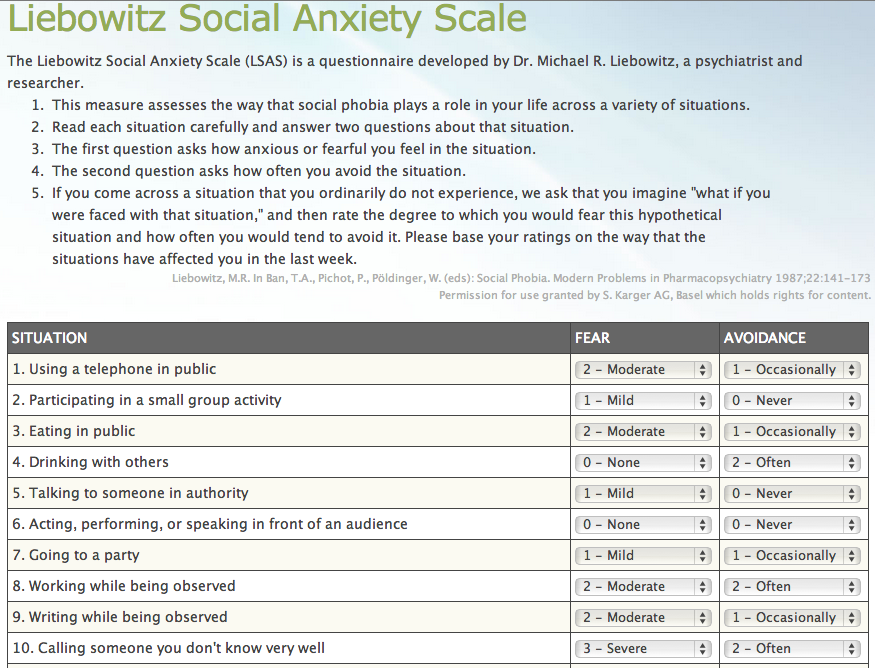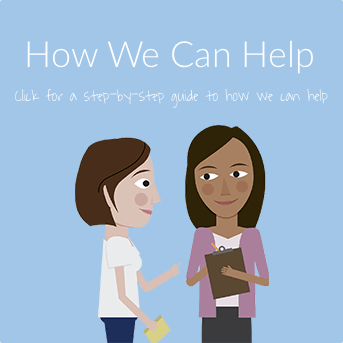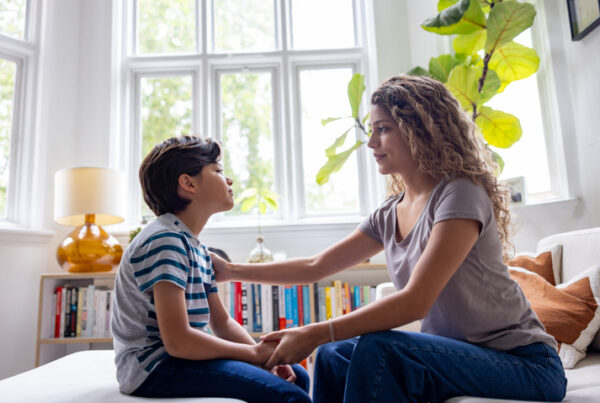1. Liebowitz Social Anxiety Scale (LSAS)
The Liebowitz Social Anxiety Scale (LSAS) is a short questionnaire used to measure how social anxiety plays a role in different life situations. This social anxiety test was developed in 1987 by Dr. Michael R. Liebowitz, a psychiatrist and researcher at Columbia University. Studies have shown the LSAS to be a cost-effective and efficient way to identify those with social anxiety. The scale features 24 items, 13 relating to performance anxiety and 11 dealing with social situations. Originally designed to be administered by a clinician, it has since become a popular self-report scale (technically, the LSAS-SR) because of its ease of use. We have a version of the Liebowitz Social Anxiety Scale on our homepage because it provides meaningful results.

2. Social Phobia Inventory (SPIN)
The Social Phobia Inventory (SPIN) is a questionnaire developed by Dr. Jonathan Davidson at Duke University for screening and measuring generalized social anxiety disorder. The assessment scale consists of 17 items covering the spectrum of social phobia such as fear, avoidance, and physiological factors. Each item is ranked by the test taker on a scale of intensity, from “Not at All” to “Extremely” and assigned a corresponding number value. A score higher than 19 indicates likelihood of a social anxiety disorder.
See also: our new Social Anxiety Community Forum
3. Mini-Social Phobia Inventory (Mini-SPIN)
The Mini-Social Phobia Inventory (Mini-SPIN) is an abbreviated instrument based on the SPIN (above) developed by Dr. Jonathan Davidson at Duke University. Here also, each item is ranked by the test taker on a scale of intensity, from “Not at All” to “Extremely.” Despite its brevity (only 3 items), the Mini-SPIN has been found to accurately differentiate between people with and without generalized social anxiety disorder.
4. Social Interaction Anxiety Scale (SIAS) and Social Phobia Scale (SPS)
In the study of social anxiety, it is common to differentiate between social interaction and performance anxiety. Mattick and Clarke (1998) designed the Social Interaction Anxiety Scale (SIAS) to assess social interaction anxiety and the Social Phobia Scale (SPS) to assess fear of scrutiny by others during routine activities (eating, drinking, writing, etc.). These scales are often administered together. Both scales consist of 20 items, which are rated 0 to 4; total scores range from 0 to 80. The two tests possess good convergent and discriminant validity, having been shown to discriminate between clinical conditions, people with social phobia, and those without. Together they have become some of the most popular tests administered by psychologists.
5. Social Phobia and Anxiety Inventory (SPAI)
The SPAI assesses specific somatic symptoms, cognitions, and behaviors across a wide range of potentially fear-producing situations to measure social anxiety and fear. SPAI results are particularly useful for discriminating between panic disorder, agoraphobia, and social phobia. This 45-item test is an ideal screening instrument for schools, outpatient clinics, hospitals, residential treatment facilities, prisons and other correctional environments, and employment settings. For example, the SPAI can help monitor treatment change and detect those who may suffer from maladaptive social anxiety. In corporate settings, the SPAI helps distinguish those who may have difficulty in positions requiring high levels of social interaction (sales) and social performance (speeches). With a sixth grade reading level, the SPAI is appropriate for individuals who are 14 years of age or older.
6. Fear of Negative Evaluation Scale (FNE)
Fear of Negative Evaluation, developed by Watson and Friend, assesses the degree to which people worry about how they are perceived and evaluated by others. The authors describe FNE as “apprehension about other’s evaluations, distress over their negative evaluations, and the expectation that others would evaluate oneself negatively.” (1969) Their Fear of Negative Evaluation Scale (FNE) is a 30-item self-report measure of social anxiety running from high fear of negative evaluation by others to no apprehension about other’s evaluations. The FNE has been shown to correlate with measures of anxiety, depression and general distress. The FNE has not been shown to correlate strongly with other measures of social apprehension.
7. Social Avoidance and Distress Scale (SADS)
The Social Avoidance and Distress Scale (SADS) contains 28 items, 14 of which assess social avoidance and 14 of which measure social anxiety. The SADS was developed by David Watson and Ronald Friend and is closely related to their FNE.





2 Comments